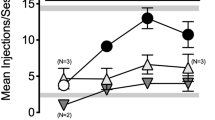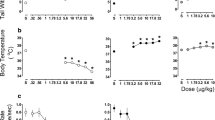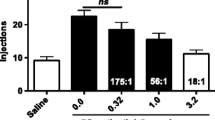Abstract
The present study investigated the rate-decreasing effects of several mu (morphine andl-methadone) and kappa (bremazocine, U69,593 and U50,488) opioid agonists in pigeons. Mu and kappa agonists were examined alone, in combination with naltrexone or the mu-selective opioid antagonist, β-funaltrexamine (β-FNA), and in pigeons treated chronically with U50,488. Naltrexone was equipotent in shifting the morphine,l-methadone and bremazocine dose-effect curves to the right, but was less potent in shifting the U69,593 dose-effect curve and did not shift the U50,488 dose-effect curve. β-FNA shifted thel-methadone dose-effect curve to the right but did not shift the bremazocine, U69,593 or U50,488 dose-effect curves. Pigeons that developed tolerance to U50,488 following daily administration were cross-tolerant to bremazocine but not tol-methadone. Taken together, these experiments indicate that the rate-decreasing effects of morphine andl-methadone are mediated by mu opioid receptors, whereas the rate-decreasing effects of bremazocine, U69,593 and U50,488 in pigeons differ depending on the pharmacological procedures used to assess their effects.
Similar content being viewed by others
Abbreviations
- U50,488:
-
(trans (±) 3,4-dichloro-N-methyl-N-[2-(1-pyrrolidinyl)-cyclohexyl]-benzeneacetamide)
- U69,593:
-
{(5a,7a,8b)-(+)-N-methyl-N-(7-(1-pyrrolidinyl)-l-oxa spiro-(4,5) dec-8-yl) benzeneacetamide}
- β-FNA:
-
beta-funaltrexamine
References
Bronson ME, Lin Y-P, Burchett K, Picker MJ, Dykstra LA (1993) Serotonin involvement in the discriminative stimulus effects of κ opioids in pigeons. Psychopharmacology 111:69–77
Craft RM, Dykstra LA (1990) Differential cross-tolerance to opioids in squirrel monkeys responding under a shock titration schedule. J Pharmacol Exp Ther 252:945–952
Craft RM, Picker MJ, Dykstra LA (1989) Differential cross-tolerance to opioid agonists in morphine-tolerant pigeons responding under a schedule of food presentation. J Pharmacol Exp Ther 249:386–393
Dykstra LA (1990) Butorphanol, levallorphan, nalbuphine and nalorphine as antagonists in the squirrel monkey. J Pharmacol Exp Ther 254:245–252
Dykstra LA, Gmerek DE, Winger G, Woods JH (1987a) Kappa opioids in rhesus monkeys. I. Diuresis, sedation, analgesia and discriminative stimulus effects. J Pharmacol Exp Ther 242:413–420
Dykstra LA, Gmerek DE, Winger G, Woods JH (1987b) Kappa opioids in rhesus monkeys. II. Analysis of the antagonistic actions of quadazocine and β-funaltrexamine. J Pharmacol Exp Ther 242:421–427
France CP, Woods JH (1985) Antagonistic and rate-suppressing effects of opioid antagonists in the pigeon. J Pharmacol Exp Ther 236:442–447
France CP, Woods JH (1987) β-Funaltrexamine antagonizes the discriminative stimulus effects of morphine but not naltrexone in pigeons. Psychopharmacology 91:213–216
Gmerek DE, Dykstra LA, Woods JH (1987)Kappa opioids in rhesus monkeys. III. Dependence associated with chronic administration. J Pharmacol Exp Ther 242:428–436
Hayes AG, Sheehan MJ, Tyers MB (1985) Determination of the receptor selectivity of opioid agonists in the guinea-pig ileum and mouse vas deferens by use of β-funaltrexamine. Br J Pharmacol 86:899–904
Hayes AG, Skingle M, Tyers MB (1986) Reversal by β-funaltrexamine of the antinociceptive effect of opioid agonists in the rat. Br J Pharmacol 88:867–872
Hayes AG, Birch PP, Cavicchini E (1988) Evidence that the kappa agonist U50,488H has non-opioid actions. J Pharm Pharmacol 40:718–720
Herling S, Coale EH Jr, Valentino RJ, Hein DW, Woods JH (1980) Narcotic discrimination in pigeons. J Pharmacol Exp Ther 214:139–146
Ho BY, Takemori AE (1989) Serotonergic involvement in the anti-nociceptive action of and the development of tolerance to thekappa-opioid receptor agonist, U-50,488H. J Pharmacol Exp Ther 250:508–514
Ho BY, Takemori AE (1990) Attenuation of the antinociceptive action of the selective k-opioid receptor agonist, U-50,488H by ICS-205-930. Eur J Pharmacol 178:371–373
Katz JL, Goldberg SR (1986) Effects of ethylketazocine and morphine on schedule-controlled behavior in pigeons and squirrel monkeys. J Pharmacol Exp Ther 239:433–441
Leander JD (1982) Effects of ketazocine, ethylketazocine and phenazocine on schedule-controlled behavior: antagonism by naloxone. Neuropharmacology 21:923–928
Leander JD (1983) Akappa opioid effect: increased urination in rats. J Pharmacol Exp Ther 224:89–94
Lord JAH, Waterford AA, Hughes J, Kosterlitz HW (1977) Endogenous opioid peptides: multiple agonists and receptors. Nature 267:495–499
Magnan J, Paterson SJ, Tavani A, Kosterlitz HW (1982) The binding spectrum of narcotic analgesic drugs with different agonist and antagonist properties. Naunyn-Schmiedeberg's Arch Pharmacol 319:197–205
Mansour A, Khachaturian H, Lewis ME, Akil H, Watson SJ (1988) Anatomy of CNS opioid receptors. Trends Neurosci 11:308–314
Martin WR, Eades CG, Thompson JA, Huppler RE, Gilbert PE (1976) The effects of morphine-and nalorphine-like drugs in the nondependent and morphine-dependent chronic spinal dog. J Pharmacol Exp Ther 197:517–532
Millan MJ, Czlonkowki A, Lipkowki A, Herz A (1989)Kappa-opioid receptor-mediated antinociception in the rat. II. Supraspinal in addition to spinal sites of action. J Pharmacol Exp Ther 251:342–350
Picker MJ, Dykstra LA (1987) Comparison of the discriminative stimulus properties of U50,488 and morphine in pigeons. J Pharmacol Exp Ther 243:938–945
Picker MJ, Dykstra LA (1989) Discriminative stimulus effects ofmu andkappa opioids in the pigeon: analysis of the effects of full and partialmu andkappa agonists. J Pharmacol Exp Ther 249:557–566
Picker MJ, Doty P, Negus SS, Mattox SR, Dykstra LA (1990) Discriminative stimulus properties of U50,488 and morphine: effects of training dose on stimulus substitution patterns produced bymu andkappa opioid agonists. J Pharmacol Exp Ther 254:13–22
Picker MJ, Negus SS, Powell KR (1991) Differential cross-tolerance to mu and kappa opioid agonists in morphine-tolerant rats responding under a schedule of food presentation. Psychopharmacology 103:129–135
Romer D, Buscher H, Hill RC, Maurer R, Petcher TJ, Welle HBA, Bakel HCCK, Akkerman AM (1980) Bremazocine: a potent, long-acting opiate kappa agonist. Life Sci 27:971–978
Schmauss C, Yaksh TL (1984) In vivo studies on spinal opiate receptor systems mediating antinociception. II. Pharmacological profiles suggesting a differential association ofmu, delta andkappa receptors with visceral chemical and cutaneous thermal stimuli in the rat. J Pharmacol Exp Ther 228:1–12
Shearman GT, Herz A (1982) Evidence that the discriminative stimulus properties of fentanyl and ethylketocyclazocine are mediated by an interaction with different opiate receptors. J Pharmacol Exp Ther 221:735–739
Takemori AE, Larson DL, Portoghese PS (1981) The irreversible narcotic antagonistic and reversible agonistic properties of the fumaramate methyl ester derivative of naltrexone. Eur J Pharmacol 70:445–451
VonVoigtlander PF, Lewis RA (1982) U50,488, a selective kappa opioid agonist: comparison to other reputed kappa agonists. Prog Neuropsychopharmacol Biol Psychiatry 6:467–470
VonVoigtlander PF, Lahti RA, Ludens JH (1983) U50,488: a selective and structurally novel non-mu (kappa) opioid agonist. J Pharmacol Exp Ther 224:7–12
VonVoigtlander PF, Lewis RA, Neff GL (1984)Kappa opioid analgesia is dependent on serotonergic mechanisms. J Pharmacol Exp Ther 231:270–274
Wessinger WD, McMillan DE (1986) Quantitative analysis of naloxone antagonism of the discriminative stimulus properties of morphine in the pigeon. Pharmacol Biochem Behav 25:209–214
Young AM, Woods JH (1982) Limitations on the antagonistic actions of opioid antagonists. Fed Proc 41:2333–2338
Zimmerman DM, Leander JD (1990) Selective opioid receptor agonists and antagonists: research tools and potential therapeutic agents. J Med Chem 33:895–902
Author information
Authors and Affiliations
Additional information
This work was supported by US Public Health Service Grant DA 02749 from the National Institute on Drug Abuse. L.A.D. is the recipient of Research Scientist Award DA 00033 and AJM of a Research Supplement for Minority Graduate Research Assistants. Portions of this research were submitted by the first author in partial fulfilment of the requirements for the degree of Doctor of Philosophy
Rights and permissions
About this article
Cite this article
Mattox, A.J., Picker, M.J. & Dykstra, L.A. Pharmacological analysis of the rate-decreasing effects of mu and kappa opioids in pigeons. Psychopharmacology 113, 457–462 (1994). https://doi.org/10.1007/BF02245223
Received:
Revised:
Issue Date:
DOI: https://doi.org/10.1007/BF02245223




